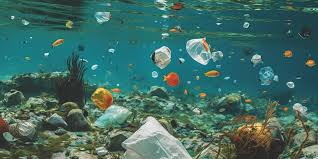
Plastic can have devastating impacts on marine ecosystems and species through ingestion and entanglement.
Microplastic pollution also compromises food chains; one study discovered that zooplankton that consume microplastics consumed 40% less carbon biomass.
Plastic debris can engulf coral reefs, blocking sunlight from reaching them and hindering their ability to thrive, thus destabilizing ecosystems that rely on them.
Ingestion
Plastic pollutants accumulating in marine and coastal ecosystems have serious ecological, socio-economic repercussions that have negative environmental and socio-economic implications, including ingestion, entanglement, toxicological effects, chemical contamination, disruption of natural behavior patterns and trophic transfer.
Large fish and marine mammals may consume plastic debris that gets lodged in their digestive systems, having adverse impacts on their growth and health – as well as being passed up the food chain to human seafood eaters.
Plastic debris in the ocean often mistaken for food by smaller marine creatures, leading to internal injury, starvation or death of these organisms. One gray whale found dead off of Seattle had 20 plastic bags and a golf ball lodged inside its stomach when it died.
Many plastics that reach our oceans come from land-based sources, including urban runoff and inadequate waste management systems. River systems act as conduits, while many individuals don’t properly dispose of their trash. Plastic debris floats with little density in water, increasing chances of being washed ashore rather than sinking to the bottom.
Chemical Contamination
Our oceans are plagued with two primary forms of marine pollution: chemicals and trash. Chemicals enter the sea through sources like accidental spills, oily wastewater dumping by tankers, fertiliser run-off and chemical-infused waste from households and industry; while trash, including plastics and abandoned fishing nets is washed or blown into the sea to accumulate into large concentrations like the Great Pacific Garbage Patch where these synthetic pollutants harm marine life in different ways.
Effects of environmental contamination range from planktonic blooms at the bottom of the food chain through fish and mammals to birds eating contaminated seafood as well as humans consuming it directly. Some contaminants may damage genetic structures, alter hormone levels or interfere with fat storage and metabolism – with even simple exposure causing serious problems for human health.
Chemical pollutants can disrupt natural behaviors and trigger destructive feedback loops within species. For instance, toxic discharges that kill invertebrates cause fish to travel further in search of prey — creating greater stress and risk exposure, magnifying its effect.
Disruption of Natural Behavior Patterns
Plastic debris washing up on beaches may be mistaken by sea birds as food and eaten, or fed to young chicks, by them. Consumption can cause internal injury or even death and become part of their food chain where larger fish, marine mammals and human seafood consumers could eventually consume it as well.
Plastic production chemicals may leach into nearby waters and sediments, polluting living organisms in their immediate environment and potentially being absorbed by marine mammals and birds as fatty tissue contaminants.
Plastic debris floating on the water surface often causes animals and boats to become entangled, while their low density allows it to float on top, which increases chances of entanglement with them. Furthermore, many types of plastic resemble natural materials like sand in appearance causing animals to mistake them as food and injure themselves when mistakenly eating plastics which they mistake for food (albatrosses entangled in fishing nets frequently mistake plastic for food that can lead to serious injuries due to mistaking it as food). This phenomenon makes plastic particularly dangerous as these injuries often result from mistaking plastics they mistake for food instead.
Bioaccumulation
Chemicals such as mercury and Polychlorinated Biphenyls (PCBs) can be found in high concentrations in marine organisms like fish, seabirds, whales and dolphins due to bioaccumulation. This process occurs when toxicants build up over repeated exposure starting at lower trophic levels before moving up the food chain – small amounts are absorbed by plants which then feed on animals before becoming consumed by higher level consumers who tend to accumulate more toxic substance than lower level predators.
Plastics can act as carriers for chemical pollution that accumulates inside animals’ bodies through bioaccumulation. This is especially true for persistent organic pollutants (POPs) which are resistant to biodegradation; thus policies, regulations, and initiatives at global, regional and national levels that prevent accumulation sources play an integral part in decreasing harmful accumulation in marine ecosystems.

